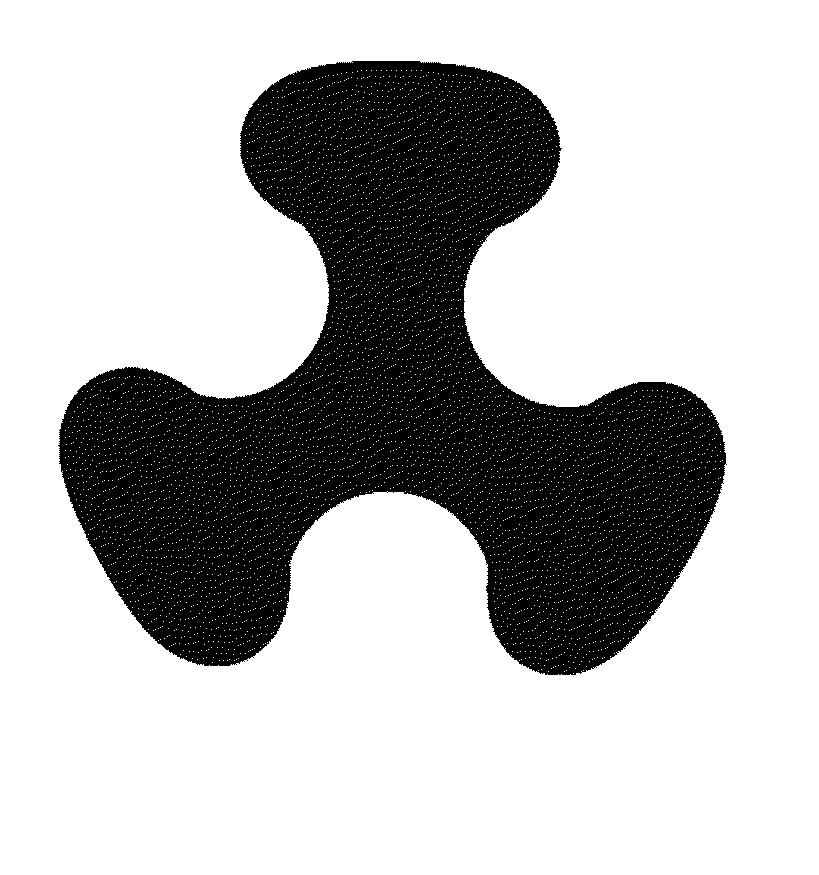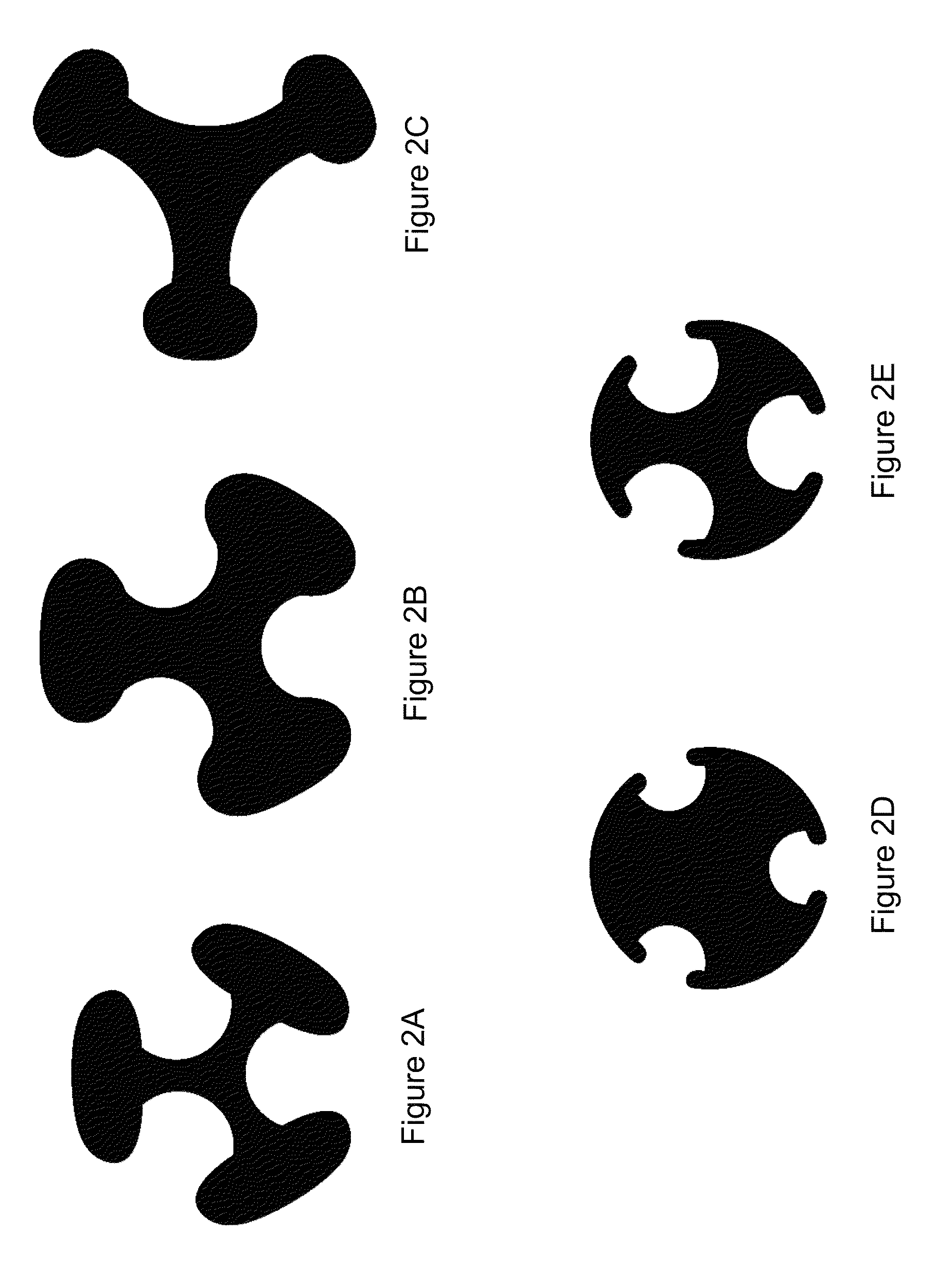Process of making tri-arc filaments
a tri-arc filament and filament technology, applied in the field of spinneret, can solve the problems of particulates escaping the filter area, being inhaled by consumers, and not being easily accepted by consumers for the feel, taste or draw strength of smoking devices
- Summary
- Abstract
- Description
- Claims
- Application Information
AI Technical Summary
Benefits of technology
Problems solved by technology
Method used
Image
Examples
example 1
[0137]Two spinnerets with tri-arc holes were produced by hand with a die punch having a tri-arc hole shape, where Spinneret A has a radius (R) of 40 microns, and Spinneret B has tri-arc holes with a radius (R) of 40 microns.
[0138]Tri-arc filaments were spun from a dope comprising cellulose acetate and acetone at a speed of 365 m / min, a dope temperature of 72° C., an air temperature of 80° C., and an elongation of about 28-30%. The total denier of the produced tri-arc filaments ranged from about 5.7 dpf to about 6.9 dpf. Y-shaped cellulose acetate filaments with a similar dpf were used as a control.
[0139]FIGS. 8A-B provide optical micrographs of the cross-sections of the tri-arc A filaments and the tri-arc B filaments. FIG. 8A shows three-tip filaments having large bulbous tips that often touch. FIG. 8B shows three-tip filaments having large bulbous tips that rarely touch and have a higher void volume between tips than tri-arc A filaments.
[0140]The filaments of the various samples (t...
example 2
[0141]Tri-arc filaments having about 16-18 denier per filament were prepared with two spinnerets having different tri-arc holes having a radius (R) of about 60-70 microns. Spinneret C with tri-arc C holes had an inter-arc angle (α) of about 60°, and spinneret D with tri-arc D holes having an inter-arc angle (α) of about 120°. For both, a dope comprising acetone and cellulose acetate was spun using the respective spinneret, a draw-down speed of about 350 m / min, a dope temperature of 72° C., an air temperature of 85° C., and an elongation of about 29-37%.
[0142]FIGS. 9A-B provide optical micrographs of the tri-arc C holes and tri-arc C filaments, respectively. Specifically, FIG. 9A shows a tri-arc C hole with an arc distance (C) of about 0.07 mm and an inter-arc distance (L) of about 0.058 mm. FIG. 9B shows cross-sections of the produced tri-arc C filaments having three large bulbous tips.
[0143]FIGS. 10A-B provide optical micrographs of the tri-arc D holes and tri-arc D filaments, resp...
example 3
[0144]Tri-arc filaments having about 6-8 denier per filament were prepared with two spinnerets having different tri-arc holes having a radius (R) of about 25-40 microns. Spinneret E with tri-arc E holes had an inter-arc angle (α) of about 60°, and spinneret F with tri-arc F holes having an inter-arc angle (α) of about 120°. For both, a dope comprising acetone and cellulose acetate was spun using the respective spinneret, a draw-down speed of about 365 m / min, a dope temperature of 72° C., an air temperature of 80° C., and an elongation of about 28-44%.
[0145]FIGS. 11-12 provide optical micrographs of the tri-arc E filaments and tri-arc F filaments, respectively. Specifically, FIG. 11 shows cross-sections of the produced tri-arc E filaments having three large bulbous tips. FIG. 12 shows cross-sections of the produced tri-arc F filaments having three bulbous tips that are slightly smaller than the tri-arc E filaments and have some arcing characteristic.
PUM
| Property | Measurement | Unit |
|---|---|---|
| diameter | aaaaa | aaaaa |
| inter-arc angle | aaaaa | aaaaa |
| inter-arc angle | aaaaa | aaaaa |
Abstract
Description
Claims
Application Information
 Login to View More
Login to View More - R&D
- Intellectual Property
- Life Sciences
- Materials
- Tech Scout
- Unparalleled Data Quality
- Higher Quality Content
- 60% Fewer Hallucinations
Browse by: Latest US Patents, China's latest patents, Technical Efficacy Thesaurus, Application Domain, Technology Topic, Popular Technical Reports.
© 2025 PatSnap. All rights reserved.Legal|Privacy policy|Modern Slavery Act Transparency Statement|Sitemap|About US| Contact US: help@patsnap.com



